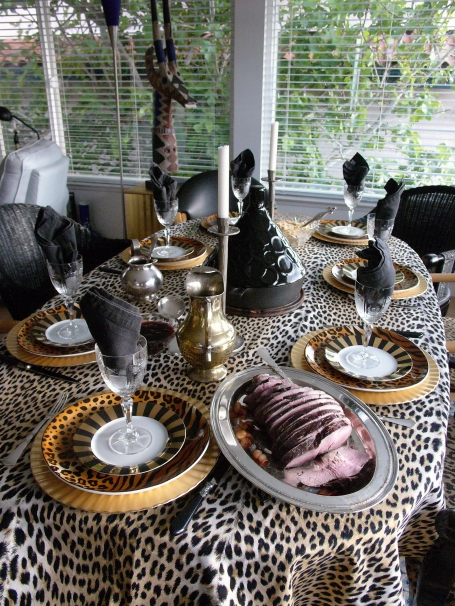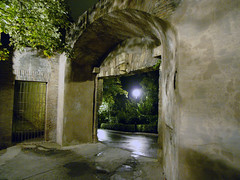Memorial Day Venison Cookoff with Apicius Roman Sauce
May 28, 2013 at 8:22 pm 3 comments

Memorial Day at my house with a Venison cookoff. That’s tajine under the lid. The roast was prepared from an authentic Roman recipe translated from the Apicius cookbook (3rd-4th century AD). The Romans used a conical ceramic cooker like the tajine dish of North Africa.
This is a meal Elektra could have eaten in Roman North Africa, only instead of venison, the host might have served a young Barbary stag or oryx. Of course, my guests would have been reclining on lounges and served by slaves. And the Zinfandel would have been watered.
The recipe for the sauce comes from one of the most famous cookbooks of antiquity. Today it is known simply as the Apicius.
There is disagreement about whether the famous epicure of the Tiberian reign (1st c AD) Marcus Gavius Apicius was the original collector or the inspiration. Most probably, he had nothing to do with the book, De re coquinaria “On the Subject of Cooking,” which eventually became known by his name.
Most scholars believe the collection of Roman cookery recipes was compiled in the late 4th or early 5th century. The language in which it was written is closer to Vulgar than Classical Latin.

An Apicius manuscript from 900 AD. The codex was originally in the monastery of Fulda, Germany but acquired by The New York Academy of Medicine in 1929.
A huge hunk of frozen venison turned out to be three roasts when defrosted. I marinated all three for 24 hours in red wine, fresh rosemary and cloves of garlic.
The smallest roast was cut into chunks for a tajine (see photos) with onions, fingerling potatoes, chunks of carrots, and tons of peas topped with baby bell peppers. Spicing: cumin, cardamon, ginger, cinnamon, clove, smoked paprika and fresh ground black pepper.
The middle-sized roast was coated in cajun spices and slow-cooked on the charcoal grill. Real charcoal please with mesquite chips! I served the Cajun venison with cherry sauce.
The large venison roast (see photo at top) was browned on all sides in olive oil and then put in a 350 oven with a few strips of bacon on top. Venison is very lean.
Now we come to the sauce from a recipe translated from the original Apicius. [Thank you to the food blog Hunter, Angler, Gardener, Cook]
I had to substitute a couple of herbs. And I used the reduced marinade for a base. I’m sure Apicius would have approved.
Ingredients for the sauce
note: all herbs are fresh, some from my own garden.
rue (I used fresh rosemary)
lovage (I used celery leaves)
oregano
mint
parsley
garlic
onion
Thai fish sauce (in place of Roman garum, the salty cured fish sauce Romans used with almost all meats and that they stole from the Greeks)
honey
sweet wine (I used Port)
salt and pepper
Not having a slave to grind the herbs into a paste, I threw them into a small food processor. You use the goodies from the bottom of the roasting pan to make a sauce much like gravies are made today. The end result should be something between a liquid and a syrup.
Salty and sweet with tons of herbs. That was the Roman taste. Also black pepper – lots of it. Even with syrupy pears.
Not sure if the Romans had cous cous, but they definitely had grain, so I suspect they might have discovered this primitive way of making pasta long before Marco Polo. I toasted slivered almonds and soaked giant raisins in brandy (until they are plump and soft) to put in the cooked cous cous.
In addition to remembering our own fallen heroes on a splendid Memorial Day, we stepped back a little further in history to remember the Romans. To borrow from the gladiators, “We who are about to eat, salute you!”
The table setting is my vision of Roman North Africa. Need to get some silver chalices!
Entry filed under: Recipes and Food. Tags: Apicius, cous cous, roast, Roman, sauce, tajine, venison.
3 Comments Add your own
Leave a comment
Trackback this post | Subscribe to the comments via RSS Feed















1. margaretpinard | May 28, 2013 at 9:30 pm
margaretpinard | May 28, 2013 at 9:30 pm
Love digging into food history like this! Looks great, and bet it tasted amazing. 🙂
2. Sandra Gore | May 28, 2013 at 11:28 pm
Sandra Gore | May 28, 2013 at 11:28 pm
Few things more enticing that digging into history. Gotta work this meal into The Black Scroll. Maybe Isis can make it for the General. Or convince Rasheed she’s actually domestic by cooking him a meal 😉
3. Ann Calhoun | May 29, 2013 at 1:08 pm
Ann Calhoun | May 29, 2013 at 1:08 pm
Wow. A Roman feast, indeed! What fun!